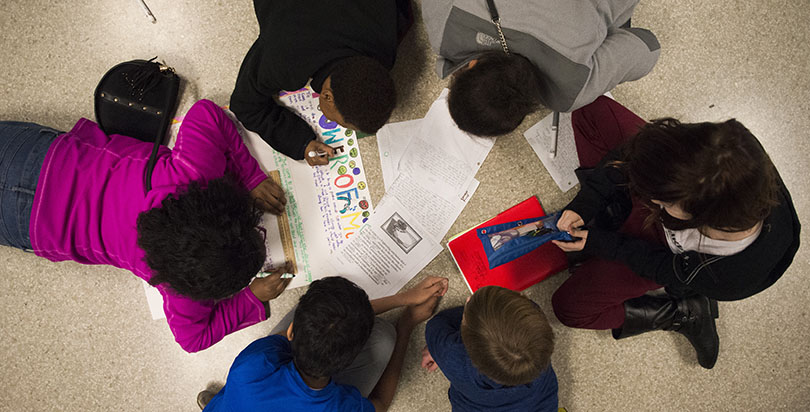Williams: When Students Own Their Academic Results, They Transform Their Schools

I started as the MCL for sixth grade, where for the previous three years the students had been experiencing negative learning growth — falling further and further behind. By my second year, my teaching team’s students exceeded the state’s expected growth targets in literacy and achieved double-digit growth in overall proficiency.
How did we accomplish this? We began by surveying our students about their interests, trying to learn what motivates them and how to better serve their needs.
From that first survey on, I saw clearly that as an MCL, I can try as hard as possible to energize, support, and coach my team of teachers, but without empowering students, the efforts won’t yield results.
I was shocked to discover in student conferences how few students knew about grade-level expectations; even fewer were aware of their own performance on the previous state end-of-grade test. I asked myself how a student could succeed without any idea of the goal — and how effective could we be as teachers if our students were not fully invested in their success.
It was time to empower our students!
The team and I immediately matched students to their appropriate reading levels. Students came face-to-face with what the average reading level should be for their grade. Many realized for the first time how much they would need to stretch themselves to get to grade level.
Three times a year, we give the Measures of Academic Progress, or MAP, assessment. Many students did not know the significance of their RIT (Rausch Unit) learning growth score from that. We printed progress reports so students could see their growth and set individual goals. Because my teachers have a heavy workload and limited instructional time, I met with students who weren’t reaching their growth goals to brainstorm how they could. They then signed a contract fully committing to improve both inside and outside of school.
In analyzing student data, we saw that we needed to set a higher bar. We raised schoolwide expectations beyond the grade-level norm, to MAP and interim assessment achievement levels 4 and 5 — college- and career-ready levels. Now, our students needed to reach even higher.
Thus began our “Strive for 5” campaign. But what good would it be for our students to Strive for 5 if our teachers didn’t adopt the same belief system?
So teachers showed their support and rewarded students’ work. On test days, we wear Strive for 5 T-shirts to encourage student achievement — meaning you will see my alter ego, Felicia Focus, striding the halls in bright sunglasses, waving a wand, with the goal for the day taped to the back of my outfit. I’m a walking billboard!
This spring, our benchmark goals for sixth- through eighth-grade reading were 223, 227, and 230—scores reflecting college and career readiness and a predicted score of 24 on the ACT, which will qualify many students for scholarships and college admission. As for students who, try as they might, don’t achieve these scores? We believe they all can be college- and career-ready, but it may take longer for some. So we challenge them to grow at least five RIT points with each benchmark.
We expect students to take charge of their data, charting their learning journey with our support. We impress upon their minds and hearts that it’s not about where you start, but how you finish the race. Middle school is not too early to focus on their futures, even for students who lack confidence now.
I ask them to think: What do you want to do with your life? What skills do you need to be successful in that role? What can you do now to help stay on the trajectory toward your goal? We explore career options and use resources like Achieve 3000 and Compass Learning to identify what their current growth scores should be in order to pass the ACT and attend their dream college.
We hear invaluable hallway conversations, with kids saying, “Yeah, I got 15 points’ growth, what did you do?” or “At first I didn’t believe I could get a score this high, but now I know I can do anything I put my mind to.” This work pushes students to do their best, regardless of where they started. And discussing growth, not grades, puts them on a more equal playing field. Meanwhile, we reward their efforts with certificates, Strive for 5 rallies, and other donations from our school’s business partners.
We also help parents understand their children’s data at family nights, where teachers explain grade-level expectations, our Strive for 5 initiative, and the need to stay connected. As an MCL, I don’t have a class of my own, but teachers and students know I will not hesitate to pick up the phone and call parents at any time. Sometimes all it takes is one positive phone call to change the relationship. When parents get more positive calls about the good things their kids are doing and understand their growth scores, they see the payoff and better support their children’s needs.
I tell the kids that they can put James Martin on the map. Their reading growth did that — we moved into the top 10 of the district’s 48 middle schools for achievement growth!
Our students dream big because their teachers dream big. And then, when students meet their goals, we celebrate! My belief is simple: “Start with heart.” It takes a strong love for students, a passion for excellence, and a belief system that challenges low expectations to achieve lasting success.
Erin K. Williams is an MCL2, a multi-classroom leader for all English language arts teachers in grades 6 through 8, at James Martin Middle School in Charlotte, North Carolina.
Get stories like these delivered straight to your inbox. Sign up for The 74 Newsletter

;)